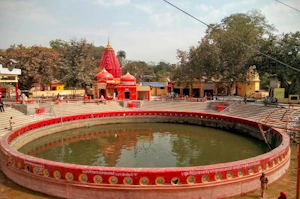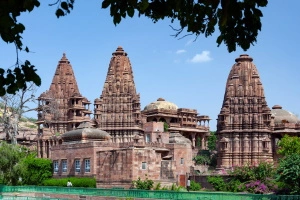Naimisharanya’s Spiritual Odyssey

Nestled in the Sitapur district of Uttar Pradesh, approximately 90 km from Lucknow, Naimisharanya (also known as Neemsar, Naimisha, or Nemisharanya) is one of Sanatana Dharma’s most ancient and sacred pilgrimage sites. Revered as the 'Foremost of All Holy Places' (Teertharaj), this forested sanctuary holds a unique position in Hindu cosmology, and spirituality. Its name derives from the Sanskrit words Nimish (a fraction of a minute) and Aranya (forest), symbolizing the land where Lord Vishnu vanquished demons in the blink of an eye.
Where Divinity and Legends Converge
According to ancient texts, Naimisharanya originated in the Satya Yuga (the first epoch of creation) as the first pilgrimage site on Earth. It is believed to be the eighth Vaikunta (abode of Vishnu) and a cosmic hub where celestial beings, sages, and mortals intersect.
- Divine Battles and Sacred Geography:
- Lord Vishnu’s Sudarshana Chakra (discus) annihilated demons here, creating Chakra Theertha, a holy pond marking the spot where Brahma’s Manomaya Chakra (cosmic wheel) fell.
- The demon Gayasura’s body split into three parts, with his navel (Naabhi) landing here, earning Naimisharanya the title Naabhi Gaya Kshetra.
- Sage Dadhichi’s Sacrifice:
- The revered sage Dadhichi donated his bones here to forge the Vajra (thunderbolt), enabling Indra to defeat the demon Vritrasura.
- Birthplace of Sacred Texts:
- Maharishi Vedavyasa compiled the four Vedas, 18 Puranas, and six Shastras at Vyasa Gaddhi, a site still venerated today.
- The Srimad Bhagavatam was first narrated here by Suta Goswami to sages, as mentioned in the Bhagavata Purana (1.1.4).
- Divine Connections:
- Lord Rama performed the Ashvamedha Yajna here, and Hanuman rescued Rama and Lakshmana from Mahiravana in Paatala, commemorated at Hanuman Garhi (featuring an 18-foot idol).
- Swayambhuva Manu and Satarupa meditated here to invoke Vishnu as their son, establishing it as a site for divine boons.
Sacred Sites
Naimisharanya’s landscape is dotted with shrines, rivers, and forests imbued with spiritual energy:
- Chakra Theertha: The primordial pond where Vishnu’s discus cleanses sins. A dip here is said to grant liberation (moksha).
- Gomati River: Revered as Adi Ganga, its banks host rituals like Pind Daan (ancestral rites), believed to elevate souls for eons.
- Lalita Devi Temple: A Shakti Peeth where the goddess’s aura empowers devotees.
- Vyasa Gaddhi: The hermitage where Vyasa meditated, surrounded by ancient banyan trees.
- Hanuman Garhi: A fortress-like temple symbolizing Hanuman’s valor.
- Suta Gaddhi: Where Suta Goswami narrated the Puranas to sages.
Spiritual Merits
Naimisharanya is celebrated as a 'Muktidayak Kshetra' (land of liberation) and 'Punyadayak Kshetra' (source of merit). Key beliefs include:
- Sin Destruction: Merely intending to visit erases half one’s sins; entering absolves all.
- Ancestral Salvation: Pind Daan here ensures ancestors attain Uttamaloka (supreme realms).
- Divine Proximity: Residing for a month equates to performing a yagna (sacrificial fire).
- Vishnu’s Vigil: The Lord, as Animisha (ever-watchful), blesses devotees who recite texts like the Vishnu Sahasranama here.
Cultural Legacy
Naimisharanya’s prominence echoes across Hindu texts:
- The Mahabharata, Ramayana, and Puranas extol its holiness.
- It is hailed as holier than Kurukshetra, Pushkar, and the Ganges, with merits multiplied tenfold.
- A 16-km Parikrama (circumambulation) path encompasses all sacred sites of India, making it a microcosm of Hindu pilgrimage.
Modern-Day Relevance
Today, the site (often called Nimsar) attracts pilgrims for:
- Sri Satyanarayana Vrata: A vow of devotion originating here.
- Charitable Acts: Gau Daana (cow donation), Vastra Daana (clothing charity), and tree planting.
- Festivals: Navratri, Kartik Purnima, and solar eclipses draw thousands.
Naimisharanya transcends time, offering both bhoga (worldly blessings) and moksha. Its forests whisper tales of gods and sages, its rivers carry prayers to the divine, and its soil embodies the essence of Dharma. For Hindus, it remains a bridge between mortal striving and eternal truth—a place where, as the Vishnu Sahasranama proclaims, the ever-vigilant Lord watches over all.
'Naimishe’nimiṣhkṣhetre' – In Naimisharanya, the abode of the Unblinking One, every step is a pilgrimage to the infinite.

English
Temples
Click on any topic to open
- 87 Naimisharanya’s Spiritual Odyssey
- 86 The Three Styles of Temple Architecture
- 85 Radha Rani Temple, Barsana
- 84 Avani Temple, Kolar
- 83 Temple as the Human Body: A Sacred Parallel
- 82 Who Truly Gains from Pilgrimage?
- 81 Shri Radha Madan Mohan Temple, Vrindavan
- 80 How Mount Abu Became Sacred
- 79 Nilathingal Thundanathan Perumal Temple, Kanchipuram
- 78 The Spiritual Significance of Temples: Roles, Rituals, and Symbolism
- 77 The Mystical Legend of Kamakhya Temple
- 76 Naganechiyan Mata - Kuldevi of Rathore Dynasty
- 75 Shri Azhagiyasingar Temple - Velukkai, Kanchipuram
- 74 Virupaksha Temple, Hampi, Karnataka
- 73 Monsoon Temple: Kanpur's Ancient Jagannath Shrine That Predicts Rainfall
- 72 Tripura Sundari Temple, Udaipur, Agartala
- 71 Ahobilam - Lord Narasimha's Sacred Abode
- 70 Malaikottai Temple, Trichy - Discover Spiritual Bliss
- 69 Jambukeswarar Temple, Trichy
- 68 Vaitheeswaran Koil - A Healing Pilgrimage
- 67 Dwaraka and Somnath
- 66 Khidkali Mahadev Mandir
- 65 Pongu Sani Temple, Thirukollikadu
- 64 The Unique And Fascinating Jharni Narasimhaswamy Temple, Bidar
- 63 Yamunotri: A Spiritual Haven in the Himalayas
- 62 Anantha Padmanabha Swamy Temple - Fascinating Legends
- 61 Akshardham Temple, Delhi
- 60 Sethu Madhava Temple Rameswaram
- 59 Discovering the Mystical Parshuram Kund: A Journey to the Sacred Site
- 58 Palani Temple
- 57 Palace Of Ravana In Lanka
- 56 Where Is Ashoka Vatika Of Ramayana?
- 55 The Greatness Of Haridwar
- 54 The Sacred Legacy of Kapila Theertham
- 53 Shakti Peethas List - With Google Maps
- 52 History and Traditions of the Pandharpur Vithoba Temple
- 51 Salasar Balaji - Infinite Blessings, Limitless Devotion
- 50 Amazing Legend Of Ashtabhuja Perumal Temple in Kanchipuram
- 49 Discover the Greatness of Jagannath's Mahaprasad
- 48 Vimala Temple, Puri
- 47 Yathothkari Perumal Temple, Kanchipuram
- 46 Naina Devi Temple, Himachal Pradesh
- 45 Devuni Kadapa Temple
- 44 Keelapatla Temple
- 43 Ardhkuwari Gufa - Vaishno Devi
- 42 Vaishno Devi Temple
- 41 Karpaga Vinayagar Temple, Pillayarpatti
- 40 Upamaka Sri Venkateswara Swamy Temple
- 39 Thondamanadu Sri Venkateswara Swamy Temple
- 38 Goravanahalli Mahalakshmi Temple
- 37 Doddagaddavalli Lakshmi Devi Temple
- 36 Rameswaram Temple, Tamil Nadu
- 35 Pandava Thoothar Perumal Temple, Kanchipuram
- 34 Nathdwara Srinath Ji Temple
- 33 Thirukalukundram Temple
- 32 108 Divya Desam
- 31 Varadaraja Perumal Temple, Kanchipuram
- 30 Jyotirlingas In Maharashtra
- 29 Explore the Timeless Greatness of Parthasarathy Temple, Triplicane
- 28 Nava Tirupati
- 27 Banke Bihari Temple Miracles
- 26 Brihadeeswarar Temple, Tanjavur
- 25 Dharmasthala Temple
- 24 Udupi Sri Krishna Temple
- 23 Kailash Mansarovar
- 22 Shankarpal
- 21 Panch Kedar
- 20 Thiruvannamalai Temple
- 19 Tiruvallur Temple
- 18 Sriperumbudur Temple
- 17 Guruvayur Temple
- 16 Rules To Be Observed Inside Temples
- 15 Vaikhanasa Agama
- 14 Dwaraka
- 13 Pancharatra - Vaishnava System Of Worship
- 12 Saivagamas
- 11 Horanadu Annapoorneshwari Temple
- 10 Dwaraka Tirumala - Chinna Tirupati
- 9 Sri Kalahasti Temple
- 8 Sankarankovil Temple
- 7 Sanwaliya Seth Mandir
- 6 Visit Kuberar Temple in Vandalur for Wealth and Prosperity
- 5 A Shiva Linga which gets struck by lightning every twelve years
- 4 Anjani Mahadev Mandir in Manali - Experience the Spiritual Bliss
- 3 Hasanamba Temple
- 2 Putlur Amman Temple
- 1 Srivaikuntam Temple
7
30
Astrology
Atharva Sheersha
Bhagavad Gita
Bhagavatam
Bharat Matha
Devi
Devi Mahatmyam
Ganapathy
Glory of Venkatesha
Hanuman
Kathopanishad
Mahabharatam
Mantra Shastra
Mystique
Practical Wisdom
Purana Stories
Radhe Radhe
Ramayana
Rare Topics
Rituals
Rudram Explained
Sages and Saints
Shiva
Spiritual books
Sri Suktam
Story of Sri Yantra
Temples
Vedas
Vishnu Sahasranama
Yoga Vasishta